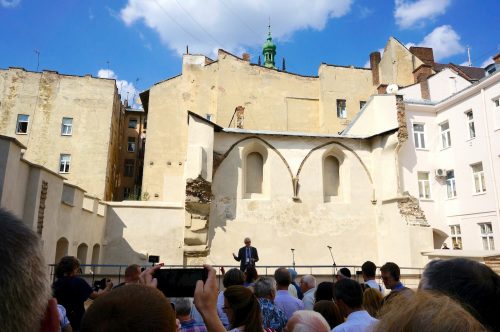Nash Holos: Architecture and Memory
Welcome to Ukrainian Jewish Heritage on Nash Holos Ukrainian Roots Radio. I’m Peter Bejger.
Architecture and memory. Restoration and commemoration.
Cities and towns throughout Europe after the Holocaust have grappled with the issue of historic Jewish sites. Buildings once alive with dynamic communities can now sit in ruins.

How can these haunted places be properly reintegrated into the contemporary life of cities? What do you need to consider? And to remember?
The Western Ukrainian website Zakhid.net recently featured a lively dialogue on these issues between Dr. Sergey Kravtsov of Hebrew University in Jerusalem and Dr. Sofia Dyak of the Center for Urban History of East Central Europe in Lviv.
Kravtsov, a specialist in synagogue architecture, was born, trained, and worked as an urban planner and architect in Lviv. Both he and Dr. Dyak have been involved in the discussions around Lviv’s historic Golden Rose Synagogue. This architectural landmark was destroyed by the Nazis in the Second World War.
Kravtsov noted that Jewish neighborhoods have been wiped off the map of Central and Eastern Europe. However, thanks to history, memory, and art, a mental map of this Jewish world remains. The possibility to transform this mental map into a meaningful and attractive urban space depends on several factors.
First of all, current residents in a city—and for the most part they are now non-Jewish—should recognize and accept the value of this history and memory.
Secondly, this current generation needs to express its attitude to the historical rupture through which Jewish districts were left empty.
Thirdly, this generation should find the adequate social, artistic, architectural, and urban planning means to express their will. This is often through a grassroots movement helped by enlightened public and private benefactors. This happens throughout Europe and one can turn to experience in Poland, the Czech Republic, Germany, and Italy.
Kravtsov points to a positive example in Vienna, the Judenplatz. This complex creatively combined a memorial to Nazi victims along with the recovered ruins of a medieval Jewish synagogue destroyed in the 15th century. Urban planners found a place for everything.
The citizens of Lviv can act creatively with the ruins of the Golden Rose synagogue. Of course this all should be discussed with the Jewish communities of Lviv, and those descended from Lviv who have left but maintained contact with the city.
There have been extensive discussions to rebuild the Golden Rose Synagogue. But Kravtsov concedes reconstruction is a very radical step and requires the consensus of all of society. The community should ask itself what do they mean to say in the reconstruction of the synagogue. And one should be frank in the search for answers.
Also communities should understand the meaning of the gradual ruination of the Golden Rose, a building cut adrift. It is theoretically and technically possible to rebuild the synagogue. There are successful precedents in Europe for the reconstruction of ruined synagogues.
But ultimately why is it important to preserve Lviv’s, or indeed Ukraine’s, Jewish heritage? Is it possible to preserve and raise awareness of the history of the Jews and Jewish heritage as a component of a country’s history and heritage?
Kravtsov believes the Jewish heritage of Lviv is important to preserve for the same reason one should preserve every heritage. A heritage is preserved for its value and transmission to posterity. There are those who want to remove any trace of something that has no right to exist in their imagined future. The Nazis acted in this manner. This barbaric manner of thinking must be eradicated through education.
The recognition of the Jewish heritage as an element in the joint history and heritage of a city is a complex issue. People can work together to abandon divisions and stereotypes. They can cultivate within themselves a tolerance and curiosity about the other, and avoid value judgments. Experience shows that through good will communities can move forward to inclusive attitudes on commonly appreciated memorial spaces.
This has been Ukrainian Jewish Heritage on Nash Holos Ukrainian Roots Radio. From San Francisco, I’m Peter Bejger. Until next time, shalom!
The audio file is here.



















